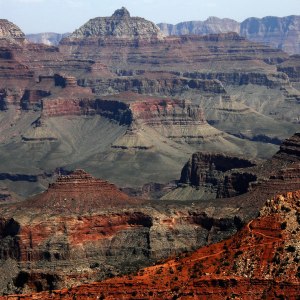Monthly Archives: May 2018
Grand Canyon Unconformities –and a Cambrian Island
I have discussed the Grand Canyon myself at https://paulbraterman.wordpress.com/2018/03/09/why-science-needs-philosophy-cont-and-why-it-matters-with-examples-from-geology/ , and strongly recommend this beautifully written and illustrated guide to its unconformities
A prominent ledge punctuates the landscape towards the bottom of the Grand Canyon. It’s the Tapeats Sandstone, deposited during the Cambrian Period about 520 million years ago, when the ocean was beginning to encroach on the North American continent, an event called the Cambrian Transgression. Above the ledge, you can see more than 3000 feet of near-horizontal sedimentary rocks, eroded into cliffs and slopes depending on their ability to withstand weathering and erosion. These rocks, deposited during the rest of the Paleozoic Era, are often used to demonstrate the vastness of geologic time–some 300 million years of it.
 View of the Grand Canyon from the South Rim trail. Arrows point to the Tapeats Sandstone.
View of the Grand Canyon from the South Rim trail. Arrows point to the Tapeats Sandstone.
But the razor-thin surface between the Tapeats and the underlying Proterozoic-age rock reflects the passage of far more geologic time –about 600 million years where the Tapeats sits on top the sedimentary rocks of the Grand…
View original post 1,081 more words
Why historical science is the best kind of science
This is for a planned wide-audience writing project on evolution, in which I pre-empt (rather than respond to) creationists’ counter-arguments, such as their downplaying of historical science. I would greatly value comments on this approach.
There are sciences, such as physics and chemistry, where we can perform experiments. There are other sciences, such as the science of planetary motion (and astronomy in general) where we cannot do this, but we can still carry out repeated observations in well-controlled circumstances, and devise theories with whose help we can make definite predictions. All of these are what I will call rule-seeking sciences. At the other extreme, we have sciences such as palaeontology and much of geology, which one might call historical sciences.1 With these, the aim is not so much to establish general rules, as to unravel and explain the specifics of what happened in the past. It is usual to regard the rule-seeking sciences as the most rigorous, to which the others should defer. This shows a deep misunderstanding of how science works, and, time and time again, when historical and rule-seeking sciences have come into conflict, it is historical science that has triumphed.
A few examples. The rocks clearly show (for detailed arguments, see e.g. here) that the Earth, and by implication the Sun, Read the rest of this entry

